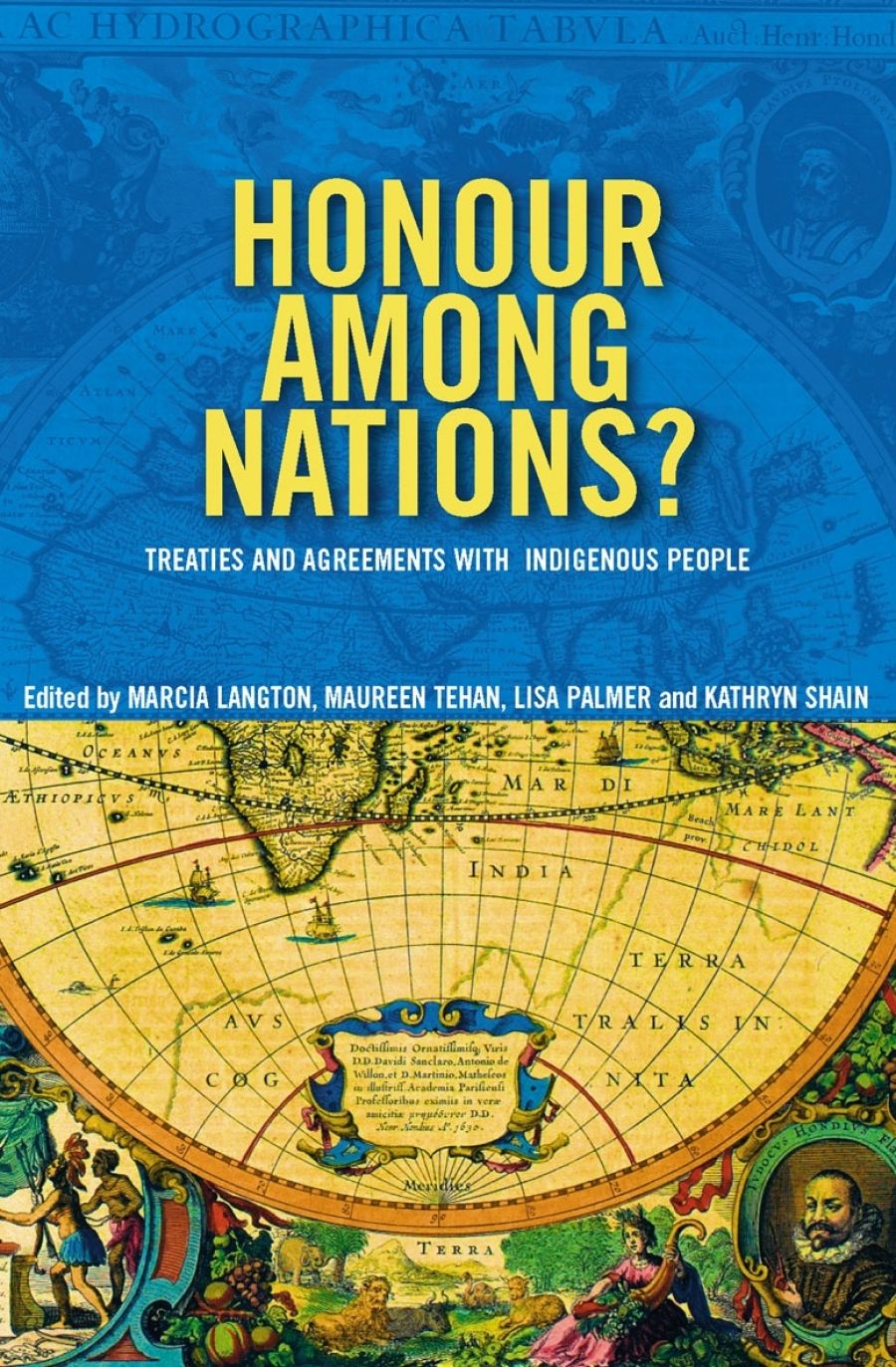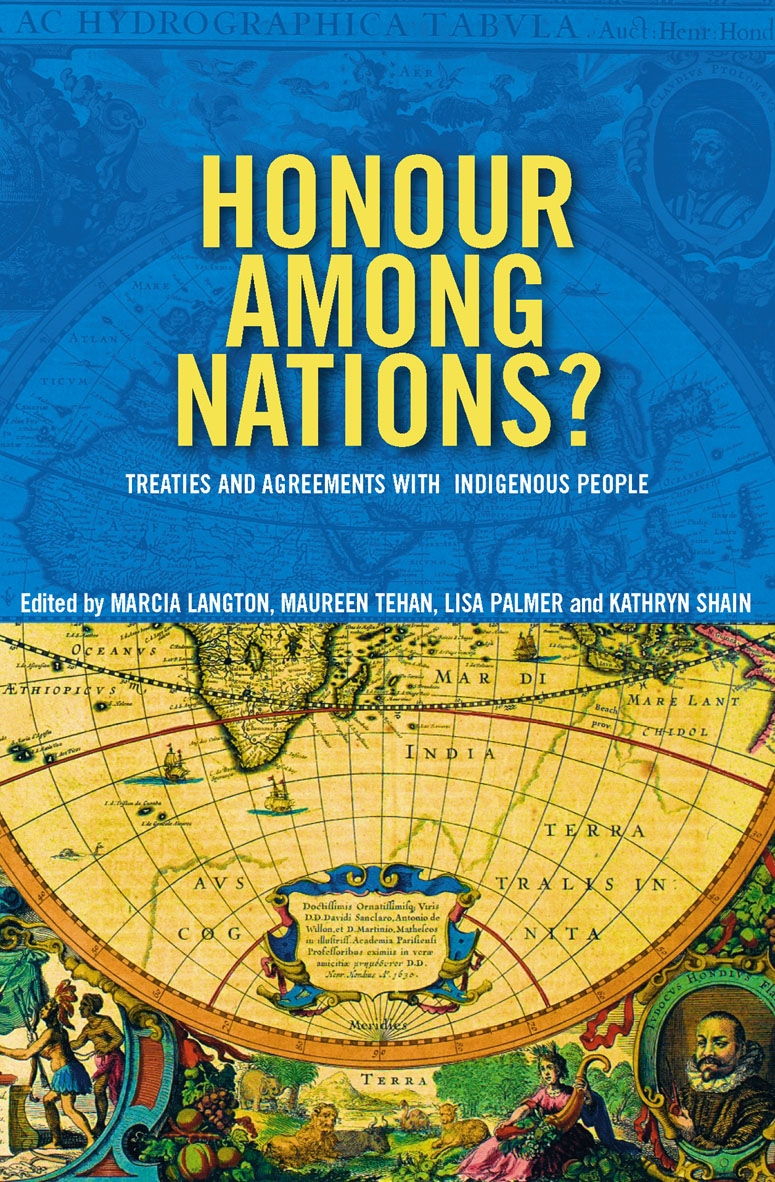
- Free Article: No
- Contents Category: History
- Review Article: Yes
- Article Title: Honour is Wanting
- Online Only: No
- Custom Highlight Text:
The word ‘honour’ is rarely heard in contemporary Australian English. It belongs to a time when the public behaviour of individuals and governments was judged by standards found in a moral code with its roots in medieval chivalry. To be ‘honourable’ was to be known for doing right. When honour was lost, disgrace followed. With the disappearance of ‘honour’ from our public language, perhaps we have also lost the possibility of disgrace.
- Book 1 Title: Honour Among Nations?
- Book 1 Subtitle: Treaties and Agreements with Indigenous People
- Book 1 Biblio: MUP, $39.95 pb, 354 pp
- Book 1 Cover Small (400 x 600):

- Book 1 Cover (800 x 1200):

‘Honour’ was certainly part of the rhetorical mission of the British Empire. It kept company with words such as duty, service, justice, morality, civilisation and Christianity, words that, in the minds of the colonisers, helped to justify the conquest of the Australian continent. By applying the honour test to the conquest of indigenous peoples, as Marcia Langton and her three co-editors have done, an important question is put. ln terms of treaties and agreements made with indigenous people, and when compared to nations such as Canada, New Zealand and the US, is the ‘honour’ of Australian governments intact?
John Batman’s failed 1836 attempt aside, treaties were not a feature of negotiation between imperial authorities and indigenous people in Australia. As Langton writes: ‘Aboriginal groups in Australia are yet to receive overt legal recognition of their polities by the Crown.’ At a time when the issue of a treaty has resurfaced in indigenous politics in Australia, Langton makes the interesting point that ‘in the USA, Canada and New Zealand, negotiated agreements have replaced treaties as the modern arrangement of engagement with Indigenous peoples with respect to resource use’. These agreements are now one of the most important ‘instruments of governance within and between the nation state and Indigenous nations’.
Many of the chapters have their origins in papers delivered at a 2002 seminar series at the University of Melbourne. The prose throughout, as you might expect, is functional and informative. The book is extremely valuable for those with an interest in indigenous history, politics, native title law and political negotiation generally.
The great virtue of Honour among Nations? is its comparative approach. Chapters include essays on indigenous treaties and agreements in Western Australia and Natal, Australia and NZ, Canada and the US, as well as important essays on local indigenous cases such as the Yolnu in Arnhem Land and the Timor Sea Treaty between Australia and East Timor. The third section of the book is devoted to native title and agreement making in post-Mabo Australia, while the final section comprises a general set of essays on the ‘opportunities and constraints of agreement making’.
Bradford Morse’s essay on indigenous settler treaty making in Canada throws light on a country with which Australia is often compared poorly. Morse explains that, unlike the US today, treaty and agreement making ‘form the cornerstone of the Indigenous settler relationship in Canada’. A state of affairs, he claims, that has been encouraged by the entrenchment of Aboriginal and Treaty rights in the Canadian Constitution since 1982.
This is another reminder to Australians of the potential symbolic value of constitutional change. At the same time, Morse is also acutely aware of the limits of constitutional and legal rights. While the Inuit, for example, may have ‘benefited from judicial respect for Aboriginal title over the past thirty years, the outlook for most first nations with historic treaties in Ontario and the Prairies remains grim’. Morse argues that Canadian courts must expand the understanding of these treaties to include the sharing of the country’s bounty economically. He also admits that this is unlikely to happen until Canadians come to see that they have been and remain ‘the primary beneficiaries of historic Indian-Crown treaty relationships’. In a similar fashion, constitutional recognition of indigenous people in Australia, and the protection of indigenous rights and treaty making, are unlikely to occur until non-Aboriginal Australians come to understand that they have been the primary beneficiaries of dispossession.
One of the most provocative contributions to Honour Among Nations? is made by Noel Pearson. His essay, which is essentially an exercise in legal advocacy, makes a convincing case for clarification of the native title legislation and for the reconsideration of the legal reasoning underlying recent High Court decisions on native title. Pearson argues that the recent decisions of the High Court have misinterpreted the definition of native title under the 1993 Native Title Act, fundamentally misapplying the common law to the detriment of indigenous people. These decisions, he claims, have departed from the spirit of Mabo, particularly in their refusal to draw on relevant judgments in other common law jurisdictions, especially Canada. Pearson points out that the framers of the Native Title Act of which he was one, understood the legislation as ‘protecting the common law right’ to native title. He calls for the Act to be amended to make clear, in the definition of native title, that it be illuminated not by bare assertion in respect of statutory provisions but by ‘the time honoured methodology of the common law’. Such a clarification would encourage the courts to draw on the relevant domestic and international law, ‘thereby engaging with two centuries of precedent developed throughout the English common law world’. If the courts were to follow this course, the ‘horrendous burden of proof that has been foisted on native title claimants under recent Australian law might be lifted. Largely because, as Pearson maintains, common law precedent demonstrates that ‘possession derives from prior occupation not, as Australian law now maintains, from the details of traditional laws and customs’.
One of the common themes of many of the essays collected here, as Sir Anthony Mason notes in his preface, is the potentially empowering nature of agreement making. Customary law, cultures and traditions are recognised. Every agreement strengthens indigenous governance because the very process of negotiating indigenous political rights becomes embedded in the fabric of our political culture. This is encouraging. But as many of the contributors to this volume make abundantly clear, in terms of more fundamental and symbolic recognition of indigenous people and their rights, Australia’s honour is found wanting.


Comments powered by CComment